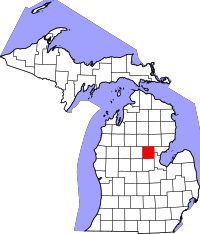Gladwin County, Michigan
| Gladwin County, Michigan | ||
|---|---|---|
|
||
 Location in the U.S. state of Michigan |
||
 Michigan's location in the U.S. |
||
| Founded | 1831 (created) 1875 (organized) |
|
| Named for | Henry Gladwin | |
| Seat | Gladwin | |
| Largest city | Gladwin | |
| Area | ||
| • Total | 516 sq mi (1,336 km2) | |
| • Land | 502 sq mi (1,300 km2) | |
| • Water | 14 sq mi (36 km2), 2.7% | |
| Population | ||
| • (2010) | 25,692 | |
| • Density | 51/sq mi (20/km²) | |
| Congressional district | 4th | |
| Time zone | Eastern: UTC-5/-4 | |
| Website | www |
|
Gladwin County is a county located in the U.S. state of Michigan. As of the 2010 census, the population was 25,692. The county seat is Gladwin.
Gladwin County is a headwaters area. Most of the water that flows out of the county via the Tittabawasee river comes from Gladwin County, only a very small portion flows in from Clare or Roscommon counties. Native Americans crossed this area, and even spent summers here where the fishing was good and summer berries plentiful.
Research is underway to determine the importance of an ancient trail that was noted by the crew of the 1839 re-survey of Township 17 north Range 2 west, which later became Beaverton Township. The eastern terminus of the "Muskegon River Trail" was plotted at the confluence of the three branches of the Tobacco (Assa-mo-quoi-Sepe) River in the northwest corner of Section 12. It is possible that an early cross-country route from Saginaw Bay to Lake Michigan proceeded up the Saginaw, Tittabawasee and Tobacco Rivers to approximately the point west across Ross Lake from the Beaverton City Cemetery. At that point the canoes would be portaged along the trail to the Muskegon river, then floated down to Lake Michigan.
Many native artifacts have been found along that route that attest to seasonal occupation, but so far no signs have been found to indicate any permanent, year-around settlement.
The earliest documented visitors to the area that later became Gladwin County were the surveyors who platted that land according to the provisions of the Northwest Ordinance. Most of the early work was completed during the 1830s. Unfortunately, parts of the first survey were actually done in a bar room in Saginaw. The surveyors had predicted it would be centuries before anyone would move to such a God-forsaken, mosquito-infested swamp.
The earliest census to mention residents in the area was in 1860.
The county is named for Henry Gladwin, British military commandant at Detroit in 1763 during Pontiac's War. The county was set off and named in 1831 and organized in 1875.
The year 2011 marked 150 years since the first permanent settler, Marvel Secord, took up residence along the Tittabawassee River in what is now Secord Township. He was a trapper and trader who provided supplies to lumbering camps in the area.
...
Wikipedia

